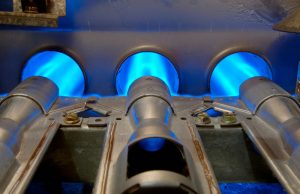Sometimes, people worry about whether a gas-burning furnace is safe to have in their homes. Well, the answer is that as long as you take good care of the furnace and have it professionally maintained, it can be very safe. That’s because modern furnaces come equipped with a variety of safety mechanisms. Perhaps most important is the heat exchanger. Here’s what you should know.
Combustion and Safety
Some components of a furnace are there to facilitate combustion. Things like gas valves and ignition systems make it possible for fuel to be burned. Some components are simply there to ensure your safety. The flame sensor makes sure gas won’t be released when there’s no flame there to burn it, and the limit switch will shut the whole system down if it starts to overheat.
The heat exchanger plays a critical role in both creating heat and keeping you safe. Here’s how it works. When fuel is combusted, this creates hot gasses. This is how your air will be heated. But the gasses can’t just mix with the air you’ll be breathing—they’re full of things like carbon monoxide that are hazardous to your health! So the combustion gasses enter the heat exchanger.
What the Heat Exchanger Does
The heat exchanger has a unique, wavy shape. This gives it a huge amount of surface area. With the hot combustion gasses inside it, fresh air can pass over and around it and absorb a great deal of the heat. This now-hot air will be blown through your ducts to heat your home. The combustion gasses, safely separated, will be dispersed out the exhaust vent.
Heat Exchanger Concerns
There is one big thing that you should keep in mind about your heat exchanger. There’s a slim chance it won’t last as long as the rest of your furnace. It is made of metal, and it is constantly heating and cooling, expanding and contracting. This will eventually make the metal more brittle, which means it could end up cracking. If there’s a crack, carbon monoxide can leak out, putting you and your family at risk.
Avoiding Heat Exchanger Cracks
Your maintenance technician will take a close look at your heat exchanger every year when they’re giving your furnace a tune-up. This is one of the reasons that heating maintenance is so important. If it is showing signs of wear, it can be replaced before any hazardous cracks occur. You should also keep watch for certain indicators that your heat exchanger is in trouble.
Signs of a Cracked Heat Exchanger
If you spot any of the following signs, you need professional help with your heating in Bigfork, MT. Your heat exchanger might be cracked!
- A flickering or non-blue flame
- A chemical odor
- A clicking sound as the furnace cools down
- Moisture or soot in the furnace cabinet
- Flu-like symptoms
- Carbon monoxide detector alarms
Don’t hesitate to get the help you need! If you have any concerns at all, have your heating system checked over by a qualified professional. Keep your home and loved ones safe as well as warm.
For all of your heating needs, contact Bill’s Superheat, Inc. today! Here to Save the Day!


